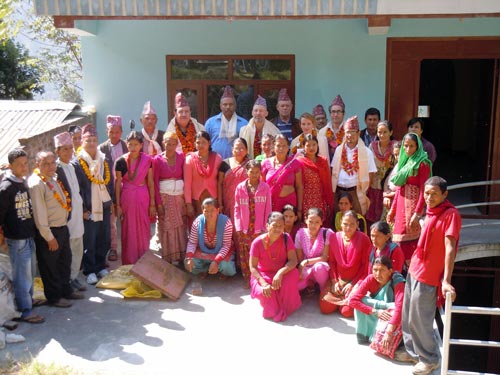 The community based seed production (CBSP) program is one of the most successful interventions of the Hill Maize Research Project (HMRP) Phase IV in Nepal. Through this program, the project has significantly contributed to the increase in maize seed replacement rate, maize productivity, and income of smallholder and resource-poor farmers in the hills of the country. To observe the successes achieved so far, teams from USAID-Nepal, CIMMYT-Mexico, and HMRP visited a community-managed seed company in the Thumpahkar Village of Sindupalchowk district, located about 100 km north-east of Kathmandu, on 12 October 2012. The USAID team comprised of John Stamm (General Development Office director, USAID-Nepal), Luis Guzman (Feed the Future team leader, USAID-Nepal), Shanker Khagi (South Asia Regional Initiative for Energy country coordinator), and Lindsey Moore (USAID-Bangladesh). CIMMYT’s Thomas Short (deputy director general for Corporate Services), Nellooli P. Rajasekharan (International Human Resources director), G. Ortiz Ferrara (HMRP team leader), Nirmal Gadal (HMRP agronomist), and Dilli KC (HMRP seed value chain and marketing expert) were also present, along with about 35 seed growers, including the management team of the company.
The community based seed production (CBSP) program is one of the most successful interventions of the Hill Maize Research Project (HMRP) Phase IV in Nepal. Through this program, the project has significantly contributed to the increase in maize seed replacement rate, maize productivity, and income of smallholder and resource-poor farmers in the hills of the country. To observe the successes achieved so far, teams from USAID-Nepal, CIMMYT-Mexico, and HMRP visited a community-managed seed company in the Thumpahkar Village of Sindupalchowk district, located about 100 km north-east of Kathmandu, on 12 October 2012. The USAID team comprised of John Stamm (General Development Office director, USAID-Nepal), Luis Guzman (Feed the Future team leader, USAID-Nepal), Shanker Khagi (South Asia Regional Initiative for Energy country coordinator), and Lindsey Moore (USAID-Bangladesh). CIMMYT’s Thomas Short (deputy director general for Corporate Services), Nellooli P. Rajasekharan (International Human Resources director), G. Ortiz Ferrara (HMRP team leader), Nirmal Gadal (HMRP agronomist), and Dilli KC (HMRP seed value chain and marketing expert) were also present, along with about 35 seed growers, including the management team of the company.
The meeting was chaired by Gunda Bahadur Dhami, chairperson of Sindhu-Tuki Seed Production Cooperative Ltd. During a brief presentation, the company’s coordinator D.B. Bhandari summarized the institutional graduation of the farmers’ groups to a cooperative and later to a private seed company. Starting in 2005, the cooperative developed into a private seed company in 2010 with the technical support from HMRP. It currently works with 300 members organized in 14 CBSP groups. Bhandari also discussed the company’s current activities, future plan, operational model, membership policy, marketing activities, and approaches to gender and sustainability.
Stamm acknowledged the project team and congratulated farmers on the impact achieved so far. “USAID-Nepal considers HMRP a very successful project, and your seed company is a model for economic development of rural areas,” he said. Rajasekharan then thanked the HMRP team for organizing the field visit and expressed CIMMYT’s commitment to support the project staff in their work aiming to improve food security among Nepalese maize farmers. Short added: “I echo Raj’s words in congratulating the members of this seed company, but I also take the opportunity to thank the two donors of HMRP, USAID and SDC, for their financial and technical support given to the project.” Ortiz Ferrara stressed that “sustainability is the prime concern of HMRP, and the entire project activities are built on the clearly defined roles and responsibilities of the multiple stakeholders.
This small seed company is now operating on its own resources, and this is only one of the 195 CBSP groups coordinated by HMRP in 20 hill districts.” Responding to a question raised by Khagi regarding the competitiveness of improved maize seed, a female maize seed grower said: “The new maize varieties are high yielding, disease and lodging tolerant, have good taste, and the grain can be stored for a longer time.” Dhami followed: “We are just learning to walk and there is still a lot to do to help small farmers in our hill area to achieve food security and increase their income.” He thanked the guests for their valuable time and their continuing collaboration with the recently established seed company. At the end of the discussion, the team observed the seed processing plant, seed store house, and the community seed bank.
 Climate adaptation and mitigation
Climate adaptation and mitigation